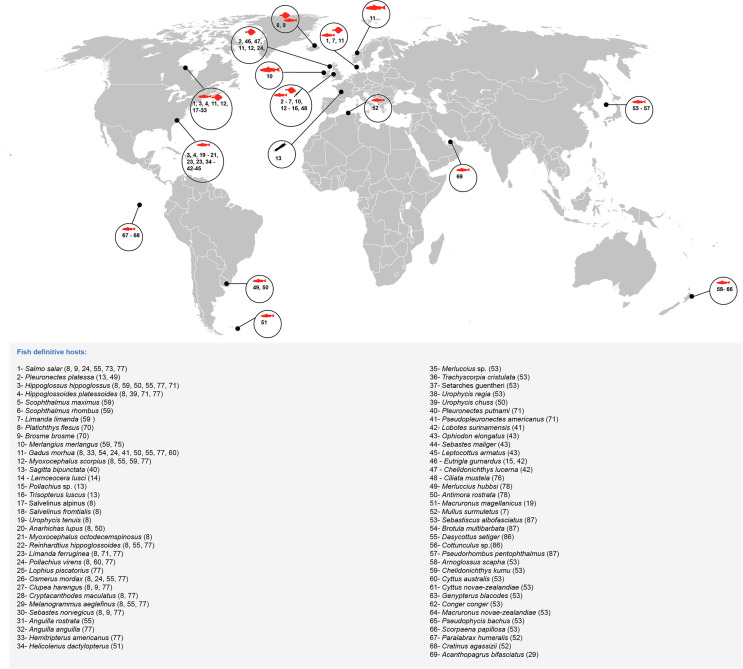隐藏在浓雾中:来自瑞典和挪威的严格意义上的Derogenes varicus(吸虫纲,Derogenidae)的形态学和分子特征,以及两个鲜为人知的Derogenes物种的重新描述。
摘要
据广泛报道,Derogenes varicus(Müller,1784 年)是一种寄主特异性极低、两极分布广泛的吸虫。然而,最近的一些研究表明,D. varicus 代表了一个物种复合体,并且根据分子证据,在 D. varicus 物种复合体中指定了四个遗传系(标记为 "DV1-4")。这种可能性需要对模式寄主(鲑鱼)和模式产地(丹麦近海)的标本进行改进(最好是分子鉴定)。在对斯堪的纳维亚和北极水域(瑞典和挪威)鱼类的颤形虫寄生虫进行检查时,我们在瑞典沿海的 Merlangius merlangus 胃中以及瑞典和挪威沿海的 Gadus morhua 胃中发现了 D. varicus 标本;我们将它们与模式宿主(挪威的大西洋鲑鱼 Salmo salar)中的 D. varicus 进行了比较,以验证它们的同种性。新生成的斯堪的纳维亚和北极标本序列(28S rDNA、ITS2 和 cox1)与 D. varicus 一致,它们组成了一个支系 DV1。来自挪威 S.salar(即靠近丹麦的模式产地)的 D. varicus 的 28S 序列与来自不同宿主(包括白海和巴伦支海(俄罗斯)的 Limanda limanda、G. morhua 和 Myoxocephalus scorpius)的 D. varicus 序列聚类在 DV1 支系中,没有任何宿主相关的结构。因此,我们认为 DV1 系代表严格意义上的 D. varicus。此外,来自 M. merlangus 的标本与来自 L. limanda、G. morhua 和 T. Odhner 收集的 M. scorpius 的 D. varicus 标本具有相似的形态和解剖结构,支持 DV1 系中存在一个物种,即本文中的 D. varicus sensu stricto。我们重新描述了 D. varicus sensu stricto,增加了新的形态特征,并提供了形态计量数据。我们推断 D. varicus 的 DV2-4 型都与单独的物种有关。我们还修改了瑞典自然历史博物馆 A. Looss 收集的 Derogenes minor Looss, 1901 的模式标本,并重新描述了它和该属的模式种 Derogenes ruber Lühe, 1900。varicus sensu stricto 的形态特征,我们恢复了 D. parvus Szidat, 1950 和 D. fuhrmanni Mola, 1912 的命名。



Derogenes varicus (Müller, 1784) is widely reported as a trematode with exceptionally low host specificity and a wide, bipolar distribution. However, several recent studies have suggested that D. varicus represents a species complex and based on molecular evidence, four genetic lineages (labeled as "DV1-4") have been designated within the D. varicus species complex. This possibility requires improved (ideally molecular) characterisation of specimens from the type-host (Salmo salar) and type-locality (off Denmark). During examination of trematode parasites of fish from Scandinavian and Arctic waters (Sweden and Norway), we found specimens of D. varicus in the stomach of Merlangius merlangus off the coast of Sweden, and in Gadus morhua off the coast of Sweden and Norway; we compared them to D. varicus from the type-host, the Atlantic salmon Salmo salar from Norway, to verify their conspecificity. Newly generated sequences (28S rDNA, ITS2 and cox1) of Scandinavian and Arctic specimens consistent with D. varicus all formed a single clade, DV1. 28S sequences of D. varicus from S. salar from Norway, i.e., close to the Danish type locality, clustered within the DV1 clade along with sequences of D. varicus from various hosts including Limanda limanda, G. morhua and Myoxocephalus scorpius from the White Sea and the Barents Sea (Russia), without any host-related structuring. We thus consider that the lineage DV1 represents D. varicus sensu stricto. Additionally, specimens from M. merlangus had a similar morphology and anatomy to those of D. varicus from L. limanda, G. morhua and M. scorpius from T. Odhner's collection, supporting the presence of a single species in the DV1 lineage designated herein as D. varicus sensu stricto. We redescribe D. varicus sensu stricto, add new morphological characters and provide morphometric data. We infer that D. varicus types DV2-4 all relate to separate species. We also revise type-specimens of Derogenes minor Looss, 1901 from the A. Looss collection in the Swedish Museum of Natural History and provide redescriptions of it and of the type-species of the genus, Derogenes ruber Lühe, 1900. In light of their morphological distinctiveness relative to D. varicus sensu stricto, we reinstate D. parvus Szidat, 1950 and D. fuhrmanni Mola, 1912.

 求助内容:
求助内容: 应助结果提醒方式:
应助结果提醒方式:


